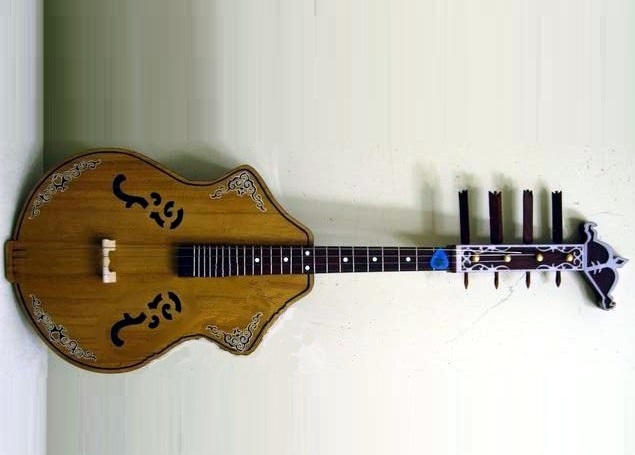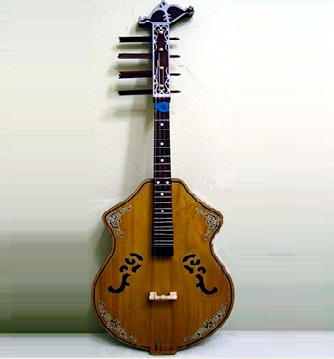Huobosi
Plucked Instruments
Asia
Between 1001 and 1900 AD
Video
The Huobosi (火不思; Huǒbùsī) is a stringed musical instrument originating from China. It occupies a place within the broader category of plucked lutes, and its design and construction reflect a blend of historical influences, particularly those stemming from Central Asian traditions. The instrument’s name itself is a transliteration into Chinese, hinting at its historical connection to Turkic musical cultures. In its modern form, the Huobosi has undergone developments that have standardized its construction and expanded its musical capabilities, making it a viable instrument in contemporary Chinese musical ensembles.
Type of Instrument
The Huobosi is classified as a chordophone, specifically a plucked lute. This categorization places it within a family of instruments characterized by the production of sound through the vibration of strings stretched across a resonating body. The act of plucking these strings, either with the fingers or a plectrum, initiates the vibrations that create the instrument’s distinctive sound. Furthermore, within the Hornbostel-Sachs classification system, it is considered a composite chordophone. This means that the instrument’s sound production relies on the combination of a string bearer and a resonator.
History of the Huobosi
The historical origins of the Huobosi trace back to Central Asia, with influences that eventually permeated into China. The instrument’s development is linked to earlier Turkic lutes, notably the kopuz, which played a significant role in the musical traditions of various Central Asian cultures. The transmission of these musical influences into China occurred over centuries, facilitated by trade routes, cultural exchanges, and migrations.
The exact century of the Huobosi’s initial introduction into China is subject to scholarly debate, but it is generally accepted that the instrument’s roots lie in the medieval period. The process of adaptation and evolution within the Chinese musical context led to the development of the Huobosi as a distinct instrument. In more recent history, especially in the 20th and 21st centuries, the Huobosi has experienced a revival and modernization. These efforts have focused on refining its design, expanding its tonal range, and integrating it into contemporary musical ensembles. It is notably used by the Naxi people in China, and has seen a transformation from older carved lutes, to modern flat backed, and bent side versions.
Construction and Design
The construction of the Huobosi involves a combination of traditional craftsmanship and modern instrument-making techniques. The instrument typically features a resonating body, a neck, and a headstock. The resonating body, which can vary in shape and size, plays a crucial role in amplifying the sound produced by the vibrating strings. Historically, the resonating body was often carved. Modern versions have seen the adoption of a flat back, and bent sides. The neck, which extends from the resonating body, serves as the fingerboard, where the player presses the strings to produce different pitches. The headstock, located at the end of the neck, holds the tuning pegs, which are used to adjust the tension of the strings.
The materials used in the construction of the Huobosi can vary, but traditionally, wood is the primary material for the body and neck. The strings themselves may be made of silk, steel, or other materials, depending on the desired tonal qualities. The design of the Huobosi reflects a balance between functionality and aesthetics, with attention paid to both the acoustic properties of the instrument and its visual appearance.
Types of Huobosi
In modern development of the Huobosi, like many other instruments, variations in size and range have been created. This has included the creation of Soprano, alto and tenor versions of the instrument. This allows for the instrument to be used in a wider variety of ensemble settings, and give composers greater options when writing music.
Characteristics of the Huobosi
The Huobosi possesses a unique set of musical characteristics that contribute to its distinctive sound. The tonal quality of the instrument is often described as warm and mellow, with a subtle resonance that allows for expressive playing. The plucked nature of the Huobosi lends itself to a variety of musical styles, from traditional folk melodies to contemporary compositions. The instrument’s range and versatility have been expanded through modern developments, allowing it to play a wider variety of musical parts. The Huobosi’s ability to blend with other instruments makes it a valuable addition to ensembles, and its expressive capabilities make it suitable for solo performances. The instrument, having strings of varying material, also allows for a diverse tonal pallet. The higher strings, often made of steel, provide a clear bright sound, where the lower silk strings provide a deeper more mellow sound. The Huobosi’s historical significance and cultural importance are also key characteristics. As an instrument with roots in Central Asian traditions, it represents a fusion of musical influences that have shaped the cultural landscape of China. Its continued presence in contemporary musical practices underscores its enduring appeal and its role in preserving and promoting traditional musical heritage.
Playing Techniques and Sound Modifications
The Huobosi, typically featuring four strings, demands a unique set of playing techniques. Historically and in modern times, it is played by plucking the strings. The instruments construction allows for a varied tonal output. The way the musician plucks the strings, and where along the string they pluck, drastically changes the tone of the instrument.
Plucking: The primary technique involves plucking the strings with the fingers or a plectrum. Variations in plucking strength and angle produce a wide range of timbres.
Harmonics: Skilled players can produce harmonics by lightly touching the strings at specific points, creating ethereal, high-pitched tones.
Vibrato: Vibrato, achieved by subtle finger movements on the strings, adds expressive depth and warmth to the sound.
Sound Modifications: The Huobosi’s sound can be modified through various techniques. The materials used in string construction, such as silk or steel, significantly impact the tone. Modern Huobosi instruments have been developed in soprano, alto, and tenor versions, greatly increasing the instruments range. Also, the placement of the hand on the resonating body can alter the resonance of the instrument.
Applications in Music
The Huobosi finds applications in various musical genres, particularly within traditional Naxi music.
The instrument holds a central role in Naxi folk music ensembles, accompanying songs and dances. Its melodic capabilities and expressive range make it ideal for conveying the emotional depth of traditional melodies. The development of different Huobosi sizes has allowed for the instruments inclusion in larger musical ensembles. It can contribute to both melodic and harmonic textures, adding a unique sonic character. Some contemporary musicians are exploring the Huobosi’s potential in modern musical contexts, blending its traditional sound with elements of other genres. This has helped to give the instrument a wider audience. historically, like many stringed instruments, the Huobosi has been used to accompany vocal music. It’s tonal qualities lend themselves well to this purpose.
Most Influential Players
Identifying specific “most influential” players can be challenging, as much of the Huobosi’s tradition has been passed down through generations within the Naxi community. However, the individuals who have contributed to:
The preservation of traditional playing techniques.
The development of modern Huobosi variations.
The promotion of the instrument through performances and recordings.
These people are very important to the instruments survival. Also, the Naxi people as a whole, are the most influential, because they have kept the instrument alive through many generations. With the rise of modern recording technology, more and more performers are able to have their performances saved, and shared with the world. This is helping to spread the knowledge of the Huobosi.
Maintenance and Care
Proper maintenance and care are essential for preserving the Huobosi’s sound quality and longevity.
String Care: Strings, especially silk ones, require regular cleaning and occasional replacement. Changes in humidity and temperature can affect string tension, so adjustments may be necessary.
Body Maintenance: The instrument’s body, typically made of wood, should be protected from extreme temperature and humidity fluctuations. Regular cleaning with a soft cloth helps prevent dust and dirt buildup.
Storage: When not in use, the Huobosi should be stored in a protective case to prevent damage.
Professional Maintenance: Periodically having the instrument inspected and adjusted by a skilled luthier is recommended to ensure optimal performance.
Humidity Control: Stringed instruments are very susceptible to damage from humidity. If the enviroment that the Huobosi is stored in is very dry, or very humid, this can cause damage to the wooden body of the instrument.
Cultural Significance
The Huobosi holds deep cultural significance for the Naxi people, embodying their musical heritage and cultural identity.
The instrument is an integral part of Naxi cultural expression, featured in traditional ceremonies, festivals, and gatherings.
Historical Preservation: The Huobosi’s history reflects the cultural exchange between different ethnic groups in China, serving as a tangible link to the past. The preservation and transmission of Huobosi playing techniques and musical traditions contribute to the continuity of Naxi musical heritage. Music plays a vital role in fostering social cohesion within the Naxi community, and the Huobosi is a key instrument in these musical expressions.
With the modernizing of China, it is very important that cultural instruments such as the Huobosi are kept alive. They are a link to the past, and help to show the rich cultural history of the many different people that live in China. The Huobosi is more than just a musical instrument, it is a symbol of the Naxi people, and their cultural identity. The Huobosi is a great example of how musical instruments evolve, and adapt to changing times. It has its roots in older Turkic instruments, and has been adapted by the Naxi people. Modern versions of the Huobosi, have been created, to allow the instrument to be played in modern musical settings. This shows how cultural items, can change, and still keep their cultural significance.
FAQ
What are the main features of the Huobosi?
The Huobosi is a traditional four-stringed plucked instrument from the Uyghur culture. It has a pear-shaped wooden body, a long neck, and metal or silk strings. It produces a bright, resonant sound ideal for folk melodies. The instrument is often decorated with intricate carvings.
What materials are used to construct the Huobosi?
The Huobosi is primarily made from mulberry or walnut wood, providing a warm tone. The strings were traditionally made of silk but are now commonly metal. The tuning pegs and frets are crafted from bone or metal. The body is sometimes lacquered for durability and aesthetics.
How is the Huobosi used in music?
The Huobosi is widely used in Uyghur folk music, accompanying dances and storytelling. It plays both melodic and rhythmic roles in ensembles. It is featured in traditional and contemporary compositions, showcasing its versatility. The instrument is also used in cultural preservation and modern fusion genres.
 Links
Links
References
Other Instrument
Categories



















